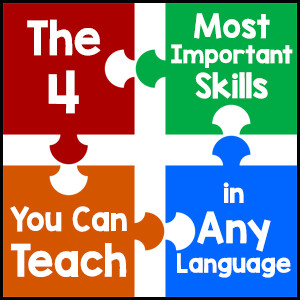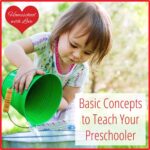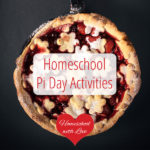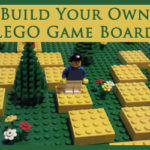
Did you know that every language is made up of four essential parts?
Do you know what they are?
If you are thinking of reading, writing, spelling and grammar, you are only partly right.
The four parts that I’m thinking of are valuable skills for effective communication in English or any other language.
Have you guessed what they are?
The four important skills for any and all languages are reading, writing, speaking and listening.
These four tools lay the groundwork for communication. As you probably already know, good communication is a valuable life skill. You can better prepare your children for a future job, college, relationships, and life by training them to communicate well using these four foundations of language.
When you incorporate all four of these important skills into your homeschooling, you are touching on all three learning styles: visual, auditory, and kinesthetic. Integrating these important skills into not only language arts, but other areas of the curriculum as well can enhance your children’s ability to learn because it creates a multisensory learning experience.
Now if you are wondering how you can incorporate these four important skills into your homeschooling, here are some suggestions:
Reading
Knowledge abounds for your children to absorb from multiple types of literary sources including:
- textbooks
- ebooks
- books you own
- library books
- periodicals
- the internet
You can use these sources as you see fit in your lessons, but don’t forget to give your kids ample time for recreational reading too. This will help foster a love of reading in your children.
Writing
There are many opportunities for writing in all areas of the curriculum. The type of writing activities you use should depend on the capabilities and interests of your children. Younger children benefit from simpler writing tasks like copywork and lapbooking. Older children can take notes and write compositions. Here is a list of activities that you might like to use in your homeschool:
- Note taking. Older children can take notes in many areas of the curriculum including History, Science, and Math.
- Copywork. Copywork can be equated with learning through imitation. Copying a specific genre such as nonsense verse teaches a child how to write in that genre.
- Dictation. This is good for both writing and listening.
- Composition. This is writing at its best and most creative. It’s an opportunity for children to put down their own thoughts and ideas on paper.
- Notebooking. Perfect for encouraging writing in other areas of the curriculum such as Science and History.
- Journaling. Journals can be a wide variety of things including nature journals, diaries, or a place for putting down ideas for future compositions. (You can get some FREE angel-themed journal pages here .)
- Lapbooking. Like notebooking, this works well in many content areas.
Speaking
There are both formal and informal situations for speaking in a homeschool. The most informal is a discussion of the subject you are studying at the moment. This can be very helpful for auditory learners. My oldest child who has a distaste for Math is an auditory learner. I discovered that the best way for her to understand a difficult concept in Math was to discuss it with her. This didn’t mean that I lectured her on how to do it. It was a sharing of knowledge. I sometimes asked her to explain to me what she understood. Then I filled in the gaps in the areas she was confused on. It worked quite well. Here are some other speaking activities that can be used in your homeschool.
- Recitation. This can include reciting poetry, riddles, jokes, digits of pi, math facts, historical documents or speeches, or concepts in science such as the levels of taxonomy.
- Narration. When children are young, you can read a simple story to them and have them narrate back to you the events of the story.
- Drama. You can find opportunities for acting in homeschool groups and children’s theater groups.
- Singing. This is “speaking” in a musical way.
- Giving a speech. Your children can give a speech on anything that interests them.
- Teaching. Can your older child teach your younger child how to do something or vice versa? Can they teach you? Being able to teach something is a sign of mastery of a subject. You can’t teach it well unless you understand it well.
- Reader’s Theater. Reader’s Theater is a fun group activity where literary text is read aloud in unison and parts. You can test it out with these FREE Reader’s Theater scripts if you like.
Listening
Since homeschooled children aren’t sitting in a classroom on a daily basis being lectured to, it’s important for you to find other activities which require listening. I have some suggestions for improving listening skills on this post, but here is list of other activities you might want to use:
- Discussion. As I said in the section on Speaking, discussion is helpful for learning, especially with auditory learners.
- Read aloud time. This is one of the best activities you can do to help your children learn to listen well. When done at a young age, it also can inspire a love of reading. Reading aloud should be a daily activity.
- Dictation exercises. Children have to listen carefully to take dictation.
- Outside classes. Classes are another useful source for giving your children practice in listening. Organizations such as homeschool groups, zoos, and museums have classes for children to participate in.
- Reader’s Theater. This requires not only good speaking skills, but good listening skills as well.
If you incorporate these four important skills into your homeschooling, you will not only not only enhance your children’s learning experiences, but also help them develop the communication skills that they can carry into adulthood.
One more thing. If you are teaching your children a foreign language, try to make sure that they have the opportunity to practice each of these four skills in the foreign language as much as possible. It will drastically improve their fluency in that language.
P.S. Are you teaching your kids Spanish? If you are looking for a FUN way to get your kids reading, writing, listening, and speaking in Spanish, you might want to try out the Say Sí to Spanish learning packs. They include board games, card games, flashcard games, word puzzles, and more to make Spanish more enjoyable for your children.







Susan, I loved this article! In fact, it was one of my favorites from last week’s Hop posts. I’m recommending it as one of the “featured posts” for tomorrow’s Hop. Thanks for sharing it with us!
Thanks for sharing it with us!
I’m glad you enjoyed it. And thanks so much for recommending it!